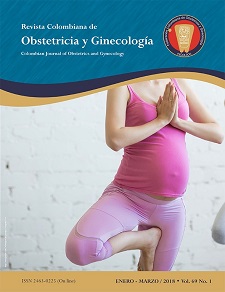Opilation and menstrual suppression: an 18th century medical prescription in the New Kingdom of Granada
DOI:
https://doi.org/10.18597/rcog.3090Keywords:
Suppression, menstruation, medical prescriptions, history, gynecology, 18th century historyAbstract
Objective: To present and define the context of a medical prescription dating from the eighteenth century in the New Kingdom of Granada, used for the suppression of menstruation, and to analyze it in the light of current knowledge as to whether its ingredients as a whole, may or may not achieve inhibition of menstrual bleeding.
Materials and methods: documentary search in the Historical Archives of the Octavio Arizmendi Posada Library at Universidad de La Sabana where the prescription "Opilation and menstrual suppression” was found. A review of the literature available in SciELO/proQuest databases was subsequently conducted for the period 1993–2015.
Conclusions: The manuscript found in the Historical Archives of the Universidad de La Sabana describe multiple ingredients that, as a whole, and analyzed in light of current knowledge, are not valid to achieve the alleged suppressive effect. However, the components of the "liquid vitriol of Mars” could be recognized as having antianemic properties, and the potential suppressive effect of prescribing vigorous exercise in the middle of the menstrual cycle, although the recipeAuthor Biographies
Carolina Vásquez Carvajal, Universidad de la Sabana
Jorge Uribe-Vergara
Julio César Martínez-Lozano
Maestría en Administración de Salud, Pontificia Universidad Javeriana; Especialización en Gerencia de Mercadeo, de la misma Universidad. Profesor de planta, Facultad de Medicina, Universidad de La Sabana, Chía (Colombia).
Alberto Gómez-Gutiérrez
Ignacio Briceño-Balcázar, Universidad de la Sabana
Médico, Pontificia Universidad Javeriana; Maestría en Ciencias con énfasis en Genética Clínica de la misma Universidad; PhD en Genética Molecular, Universidad de Newcastle Upon Tyne, Newcastle, UK. Profesor titular, Universidad de La Sabana, Bogotá (Colombia). ignaciobb@unisabana.edu.co - ignaciobricenob@hotmail.com
References
Fuentes primarias
Archivo Histórico Cipriano Rodríguez Santa María (Universidad de la Sabana) – Fondo Manuel María Mosquera – Caja 10 – Carpeta 2 – Folios 101 verso y 102 recto.
Fuentes secundarias
Sánchez Torres F. Época prehispánica. Ginecoobstetricia en Colombia. Bogotá: Universidad Nacional de Colombia; 1993. P. 6-8.
Camacaro Gómez D. Cuerpo de mujer: territorio delimitado por el discurso médico. Revista comunidad y salud. 2007;5:26-31.
Benavides Iglesias J. La menstruación: un asunto sobre la Luna, venenos y flores. Revista Medicina Universitaria. 2009;11:279-87.
Melián E. Útero, psiquis y climaterio: un acercamiento desde la endocrinología antropológica. Revista Investigaciones feministas. 2015; 6:96-208. https://doi.org/10.5209/rev_INFE.2015.v6.51500
Jahiatt B. Panel de la historia de la medicina tema monográfico. Revista de Ciencias Médicas. 2003;32:1-4.
Alzate Echeverri A. Los manuales de salud en la Nueva Granada (1760-1810). El remedio al pie de la letra. Revista fronteras de la historia. 2005;1:209-52.
Rolleston H. The history of endocrinology. BMJ. 1937;1033-36.
Pita Pico R. Las boticas en el Nuevo Reino de Granada a finales del periodo colonial: el lento camino hacia la modernidad. Medicina. 2015;37:223-41.
Jasen P. The disease of Virgins: Green Sickness, Chlorosis, and the Problems of Puberty. Helen King. CBMH. 2004;24:240-2.
Fors R. Tratado de Farmacio Operatoria ó sea Farmacia Esperimental. Barcelona.
Pérez G, Vittori D, Pregi N, Garbossa G, Nesse A. Homeostasis del hierro. Mecanismos de absorción, captación celular y regulación. Acta bioquím Clín Latinoam. 2005;39:301-14.
Pérez J. Breve historia de la hematología I: Las anemias. En: Almaguer D, editor. Hematología: la sangre y sus enfermedades. Mc-Graw Hill; 2015.
Ferré PR. Turquismos en un manuscrito de medicina o farmacología terapéutica en hebreo y judeoespañol (s. XIX). Rev Dialectol y Tradic Pop. 2004;2:31-42. https://doi.org/10.3989/rdtp.2004.v59.i2.127
Glaser C. Gránulos de Glaser, sal policresta de Glaser, sal prunela de Glaser. Universidad CEU Cardenal Herrera; 2010.
Pastor L. Recopilación de unidades de medida [citado 2018 mar 5]. Disponible en: http://luispastor.es/compartiendo/pdf/unidades-de-medida-by-luispastor.pdf
Henríquez A, Tejerizo A, Gonzáles SP, Belloso M, De Marino Y, Caba M, Villalba A. et al. Leptina, embarazo y reproducción. Clin Invest Gin Obst. 2006;33:180-93. https://doi.org/10.1016/S0210-573X(06)74112-0.
How to Cite
Downloads
Downloads
Published
Issue
Section
| Article metrics | |
|---|---|
| Abstract views | |
| Galley vies | |
| PDF Views | |
| HTML views | |
| Other views | |
















